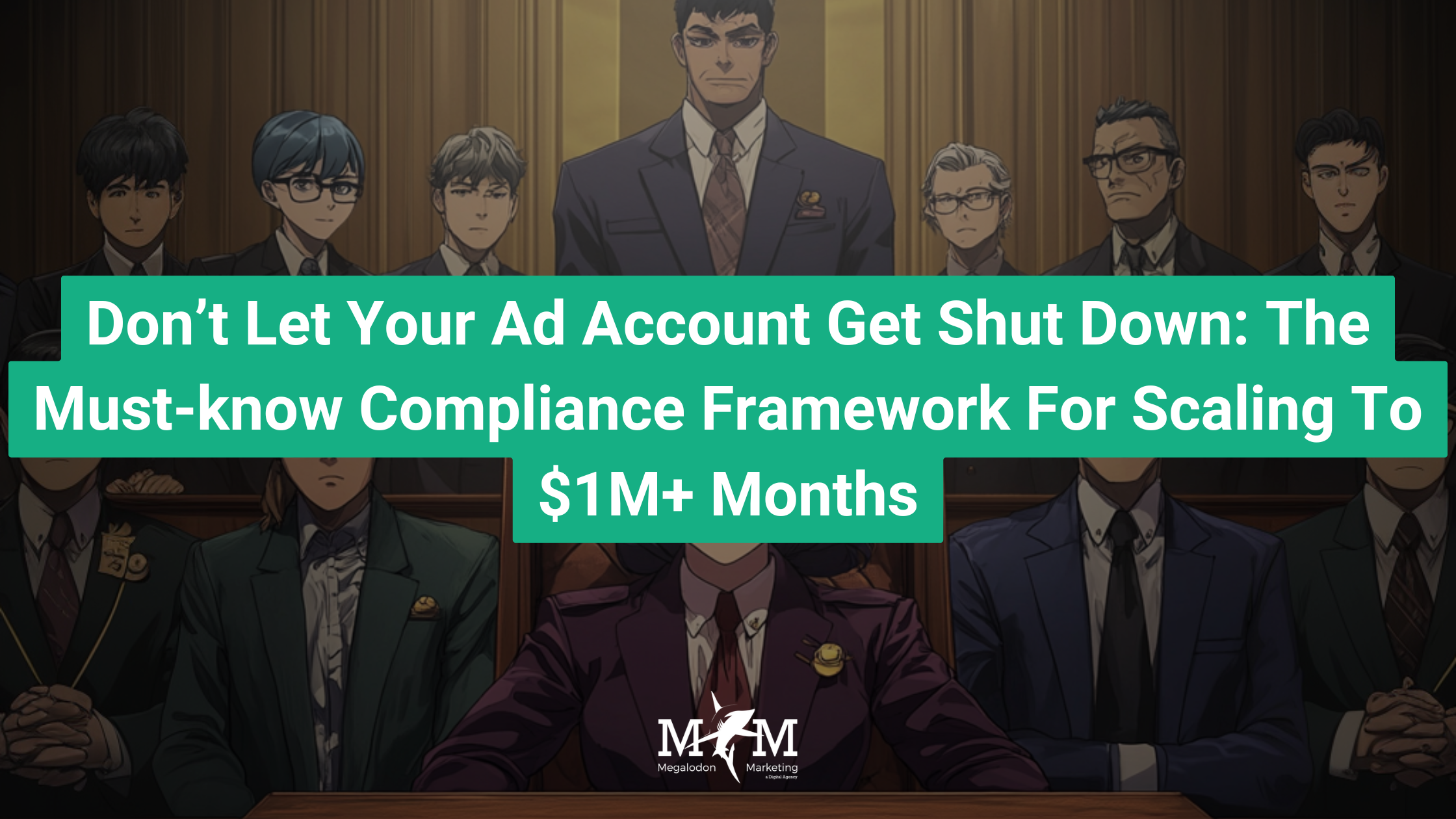I hope you enjoy reading this blog post. If you want my team to just do your marketing for you, click here.

I hope you enjoy reading this blog post. If you want my team to just do your marketing for you, click here.
Author: Jeremy Haynes | founder of Megalodon Marketing.

This material is for informational purposes and should not be construed as legal advice. Always consult legal counsel to ensure compliance with the FTC, SEC, and other relevant regulatory bodies.
Earnings Disclaimer: You have a .1% probability of hitting million dollar months according to the US Bureau of Labor Statistics. As stated by law, we can not and do not make any guarantees about your own ability to get results or earn any money with our ideas, information, programs or strategies. We don’t know you and, besides, your results in life are up to you. We’re here to help by giving you our greatest strategies to move you forward, faster. However, nothing on this page or any of our websites or emails is a promise or guarantee of future earnings. Any financial numbers referenced here, or on any of our sites or emails, are simply estimates or projections or past results, and should not be considered exact, actual or as a promise of potential earnings – all numbers are illustrative only.
A lot of entrepreneurs push to scale from mid five-figure or six-figure months to seven-figure months. Sooner or later, that mission involves paid ads. The problem arises when you add significant ad spend on platforms that are hyper-sensitive to compliance infractions—especially in any “make money” or “build wealth” space. Disapprovals, account shutdowns, or even lawsuits can annihilate your progress.
But guess what? Compliance isn’t rocket science once you realize these platforms heavily anchor their rules to one core authority: the Federal Trade Commission (FTC) in the United States (plus a few additional global regulatory bodies, depending on where you operate).
Unfortunately, many of you have been burned. You might have spent thousands on ads only to see them get shut down after one or two days. Or maybe your entire business manager got restricted suddenly, causing a meltdown. It’s infuriating because you want the scale, but you’re blindsided by compliance pitfalls you never saw coming.
Let’s end that now. Below is a framework that covers:
By the end of this, you’ll have an actionable, big-picture approach that protects your ads, safeguards your offers, and lets you scale up, especially if you’re bridging from purely organic success to more predictable growth via paid ads.
Let’s start with what really gets people burned: naming a specific amount of money and pairing it with a timeframe. Here’s what that might look like:
Any time you conjoin an income claim (that’s the “amount”) with a timeframe (like “in X days” or “in X months”), you’re basically screaming for the ad platform’s compliance AI to flag you. Not only do these direct claims violate the ad platforms’ policies, they go against core FTC requirements.
One advertiser recently asked for help because he kept getting shut down. After reviewing just 10 seconds of his video, I noticed he was promising up to 50% more salary in under 90 days. He didn’t even say a dollar figure—he just said 50% more salary in a set timeframe. That alone triggered disapprovals on his ad. Combine that with the fact that income improvement is the main promise, and you’ve got every reason for the compliance system to crack down.
Just look at major FTC crackdowns in recent years. Some well-known trainers (including those partnered with big names) got hammered for guaranteeing certain financial results in a specific period. The FTC’s stance is consistent: if you’re making a money claim that can be interpreted as typical or guaranteed, and pairing it with a timeframe, you’re in violation.
So let’s make it simple:
Golden Rule #1: NEVER make a specific, time-bound income claim (e.g., “Make X in Y days!”)
Why do Meta, Google, TikTok, and others care so deeply about all this? Easy answer: They don’t want massive fines. The FTC cracks down on consumer harm. If a platform knowingly allows misleading, hyped, or fraudulent ads to run rampant, they open themselves up to serious legal and financial repercussions.
These ad channels constantly refine their compliance algorithms to mirror the FTC’s enforcement priorities. For instance:
Bottom line: The moment the FTC makes a big public example of a certain industry, the ad platforms scramble to update their blacklists and compliance checks. They’re simply reducing their risk of liability—so you need to align your messages accordingly.
Aside from standard FTC guidelines, many platforms tack on extra rules. One common example is “branded assets.” On Facebook, that means don’t say:
Even the abbreviations (like “FB” or “IG”) can raise a red flag. The official stance is that these are trademarked terms. Using them in ads often results in disapprovals—especially if you’re teaching how to run ads on their own platforms. TikTok can have a similar standard. The key is knowing that each channel can have its own small but important set of additional restrictions.
Still, 90% of compliance is about abiding by FTC standards and avoiding brand misuses. Once you understand that, you’re ahead of most.
Take a stroll through the FTC’s website. They post press releases and settlements detailing who they cracked down on, why, and how much the fines were. You’ll see pattern after pattern—especially in “make money” niches like credit repair. Some businesses were fined hundreds of millions of dollars, mostly because they promised unrealistic outcomes.
When a settlement or ruling becomes high-profile, the ad platforms often respond by writing algorithmic updates. That’s why you see certain phrases or industries suddenly become an “instant disapproval” landmine.
If you’re in a niche adjacent to any of these categories—coaching, consulting, or courses that promise large financial gains—take the time to study these cases. Understand exactly what triggered the fines and how it might apply to your marketing language.
Compliance guidelines evolve like traffic laws. In Florida, for instance, you can get ticketed if you’re slow in the left lane. If a driver moves to a new state and doesn’t know the law, ignorance isn’t a valid excuse. You’ll still get a ticket.
Ad compliance is the same. The guidelines aren’t static because new cases keep emerging. Every time some brand gets hammered by a lawsuit for questionable marketing, the platforms see that and decide: “We need to block or limit that type of message.” The more you scale, the more you must keep up.
It’s not “unfair,” either. The platforms don’t want to become known as the place that fosters fraud or poor user experiences. The second that consumers associate a platform with spammy or bogus offers, they lose trust, ad revenue, and eventually get major regulatory heat. So watch the headlines and watch the FTC’s site. If your industry keeps popping up in those press releases, that’s a warning sign to tighten your compliance approach.
Even if you’ve learned to avoid “$10,000 in 30 days,” there are times you want to express outcomes in your marketing. As an advertiser, you must master the creative workaround. Think of it as a legal yet crafty way to highlight benefits without crossing the line.
Notice how the difference of just one word can make or break your ad. “Passive income” is a notoriously abused phrase that triggers compliance flags. “Passive returns” is far less risky because it doesn’t explicitly guarantee money or set a timeframe. Subtle but powerful.
This example keeps the emphasis on client volume rather than explicit income. Your prospects can do the math in their head if they know their average client is worth $5,000. The ad platform’s algorithm only sees “20 new clients,” which is typically viewed as an acceptable, less direct claim.
Even if you avoid making direct “earn $X in Y days” statements, you might still want to share real user success. After all, if someone in your program truly did add an extra $100,000 a month to their business, that’s a powerful story. But you cannot just post it with no context.
When you highlight a testimonial that’s well above average, you must clearly state two things:
If you’re claiming you help people hit a “million-dollar month,” you need to point out how statistically rare that truly is. By U.S. Bureau of Labor Statistics data, only 0.1% of businesses ever break $10 million a year—which is about $833k a month. That means hitting a million in 30 days is even rarer. You can’t hide that or your ad will be flagged for an unsubstantiated claim.
When I mention that someone in my network or Inner Circle hit their first $1 million month, I make it crystal clear that this result is far from typical. I’ll sometimes say:
“This student’s success is not the average result for everyone in our programs. In fact, you have a 99.99% chance of never achieving a million-dollar month, based on the BLS data. However, if you follow our methods, there is an opportunity to exceed typical norms.”
Rich clients appreciate honesty and context. They can handle complex math and probabilities. They’re not scared off by disclaimers—they’re actually reassured that you’re self-aware and not peddling fantasies.
Many high-ticket advertisers fear disclaimers might weaken their pitch. They’re afraid potential buyers will think, “Oh, well, maybe it’s not as great as they say.”
But here’s the reality: Wealthy prospects despise hype that sounds too good to be true. Their “BS radar” is finely tuned because they’ve already been sold to a thousand times. They’ve usually been burned or have seen others get burned by unrealistic promises.
If your entire brand rests on “You’ll be a millionaire in 30 days,” you might scoop up a certain segment of lower-quality leads, but you’ll lose the serious high-ticket buyers who could have been your biggest clients or best success stories. Transparent compliance makes you more credible, which ironically can increase conversions—and certainly reduces your risk of ad shutdown.
Let’s talk about a recent personal experience that underscores how important clear expectations are—especially with clients who are ready to spend money right away.
I was upgrading a website hosting plan with WP Engine. All I wanted was to hand them more money so my dev team could spin up new production environments immediately. Instead, they made me jump through phone calls, wait for an “account manager,” and only then would they grant me the ability to pay them. I was shocked by how much friction they introduced into my purchase. They set zero expectation up front that I’d ever have to talk to anyone before an upgrade, so the forced delay felt frustrating and borderline absurd.
This same friction rears its head in online programs that promise quick results but don’t clarify next steps or disclaimers. If I, as a rich client, see an ad that says “immediate improvement” but then discover I must jump through calls and other steps, I’m going to be irritated.
Moral of the story: If you tell people you’re giving them a direct route to success, you’d better show them the steps—and disclaim it properly. If there’s any waiting or gating, make that explicit from the start. This keeps the right expectations, so people don’t feel misled.
For many entrepreneurs, you’ve been organically hustling—pulling in a few hundred grand with minimal ad spend. You know there’s a wide-open path to hitting $1 million months once you dial in your paid ads. But you can’t just dump money into ad campaigns without getting your compliance guardrails in place.
In my previous trainings, I emphasized that bridging from organic to paid requires you to:
Because once you go beyond a few hundred bucks a day in ad spend, the ad platforms’ automated review systems pay even closer attention to your copy, your landing pages, and your entire funnel.
One slip—a single phrase that sounds like “Make $10k in 30 days”—can torpedo a funnel that otherwise has great messaging and real value. There’s nothing more demoralizing than seeing your best campaign get shut down over a detail that was entirely avoidable.
Take a few extra hours (or days) now to bulletproof your ads, watch your branded terms, and implement disclaimers. That time investment pays off massively in scale and stability.
You’ve just absorbed a thorough breakdown of ad compliance through the lens of scaling your monthly revenue to impressive heights. Let’s cement the main points and outline how you can continue mastering these rules:
Consider these programs if you want more direct, personalized guidance. As you’ve seen, it’s one thing to know the rules, and another to have someone who’s already launched thousands of successful campaigns look at your funnel.
Compliance doesn’t have to be a dream killer; it’s actually a business protector and credibility booster—especially when you’re targeting ambitious revenue milestones. By following these fundamentals:
No more confusion about why certain ads get shut down. No more stress about losing your entire account. Take these lessons, implement them, and watch how it transforms the stability and scale of your advertising.
Here’s the final word: Platforms don’t hate marketers. They hate the liability of unrealistic or deceptive marketing claims. Respect that boundary, learn the creative ways to position your offer, and you’ll open the door to unlimited scaling without the fear of being banned or fined.
Now, go put these rules into action, keep pushing for those higher revenue months, and always remember: you can advertise boldly, as long as you advertise compliantly.
– Jeremy Haynes
This material is for informational purposes and should not be construed as legal advice. Always consult legal counsel to ensure compliance with the FTC, SEC, and other relevant regulatory bodies.

Jeremy Haynes is the founder of Megalodon Marketing. He is considered one of the top digital marketers and has the results to back it up. Jeremy has consistently demonstrated his expertise whether it be through his content advertising “propaganda” strategies that are originated by him, as well as his funnel and direct response marketing strategies. He’s trusted by the biggest names in the industries his agency works in and by over 4,000+ paid students that learn how to become better digital marketers and agency owners through his education products.

Jeremy Haynes is the founder of Megalodon Marketing. He is considered one of the top digital marketers and has the results to back it up. Jeremy has consistently demonstrated his expertise whether it be through his content advertising “propaganda” strategies that are originated by him, as well as his funnel and direct response marketing strategies. He’s trusted by the biggest names in the industries his agency works in and by over 4,000+ paid students that learn how to become better digital marketers and agency owners through his education products.
This site is not a part of the Facebook website or Facebook Inc.
This site is NOT /endorsed by Facebook in any way. FACEBOOK is a trademark of FACEBOOK, Inc.
We don’t believe in get-rich-quick programs or short cuts. We believe in hard work, adding value and serving others. And that’s what our programs and information we share are designed to help you do. As stated by law, we can not and do not make any guarantees about your own ability to get results or earn any money with our ideas, information, programs or strategies. We don’t know you and, besides, your results in life are up to you. Agreed? We’re here to help by giving you our greatest strategies to move you forward, faster. However, nothing on this page or any of our websites or emails is a promise or guarantee of future earnings. Any financial numbers referenced here, or on any of our sites or emails, are simply estimates or projections or past results, and should not be considered exact, actual or as a promise of potential earnings – all numbers are illustrative only.
Results may vary and testimonials are not claimed to represent typical results. All testimonials are real. These results are meant as a showcase of what the best, most motivated and driven clients have done and should not be taken as average or typical results.
You should perform your own due diligence and use your own best judgment prior to making any investment decision pertaining to your business. By virtue of visiting this site or interacting with any portion of this site, you agree that you’re fully responsible for the investments you make and any outcomes that may result.
Do you have questions? Please email [email protected]
Call or Text (305) 704-0094